![]()
Pattern Making- The Late Bustle Era Bodice
![]() The Look of the 1880's
The Look of the 1880's ![]()
Patterns and Cutting Guides
In addition to studying original garments to see how fashions changed, it is also helpful
to aquaint ones self with dressmaker's systems and patterns of the era. These could be aimed toward the home dressmaker
or the professional seamstress. One of the most famous and popular was the McDowell Cutting Machine (see this link
McDowell
Cutting Machine)
This is especially helpful with flat pattern designing because it lets you see the basic shape you are trying to
achieve. I have a variety of tailors systems in my collection and for the most part use them as guides only. It
is also helpful to look at the patterns published in the fashion magazines for at home dressmaking to see how different
details are achieved when cutting out.
The below picture shows the basic bodice pieces as you will be drafting them
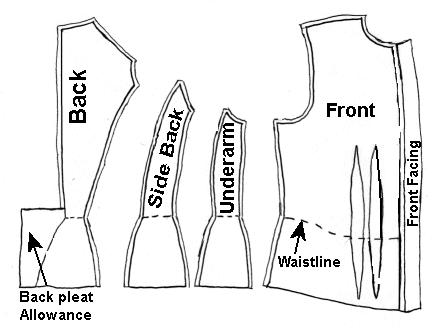
There are a variety of magazines which printed patterns, but unfortunately most had tissue
paper pattern inserts by the 1880's which unlike the pattern diagrams printed in the 1860's and 1870's had a nasty
habit of getting separated from the magazine. Diagram of pattern that was enclosed in an 1881 Peterson's Ladies National
Magazine 1884 Peterson's pattern supplement-
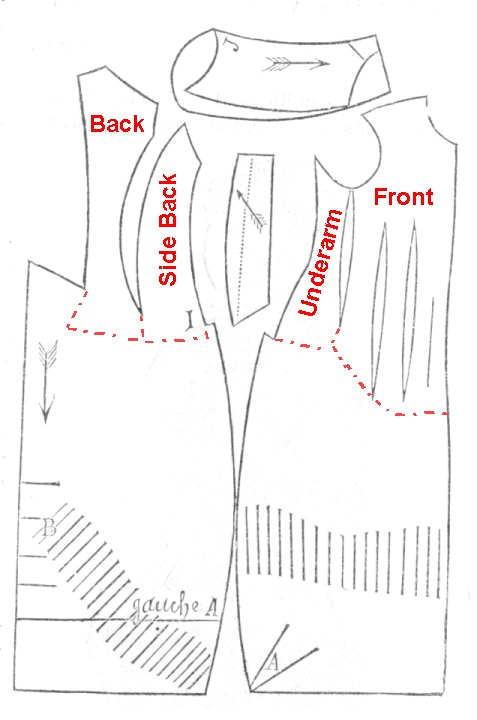

You can see the main parts of the late bustle era bodice in the polonaise pattern- (I sketched them in with red
lines)
Front fitted with two darts, underarm, side back and back
Instead of being separate the front and underarm are joined by a dart instead of a seam
as are the Back and Side Back pieces.
The sleeve is also shown with the cuff decoration sketched on. The rolling collar is also shown but not the additional
sailor collar that is shown on the fashion plate that corresponds with this pattern.

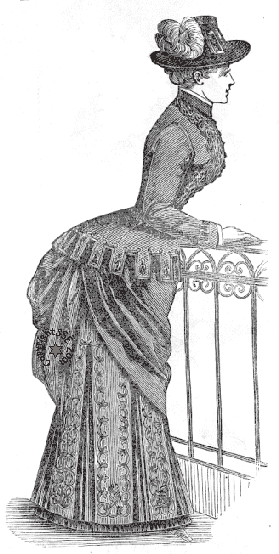
Basque Corsage: (reduced diagram)
This shows plainly our basic bodice pattern.
No 1 - Half of front
No 2- Half of Back
No 3 Half of side-back
No. 4 Half of side front (underarm)
No. 5 - Cuff
No. 6 - Sleeve
No. 7- Collar
You will see these pieces in basically the same form no matter what type of bodice you are drafting.
The main difference will generally be in decoration, the bottom edge, and how the allowance is made for the bustle.
I suggest browsing through as many period patterns as possible to get a basic
idea of pattern shapes and manipulations.
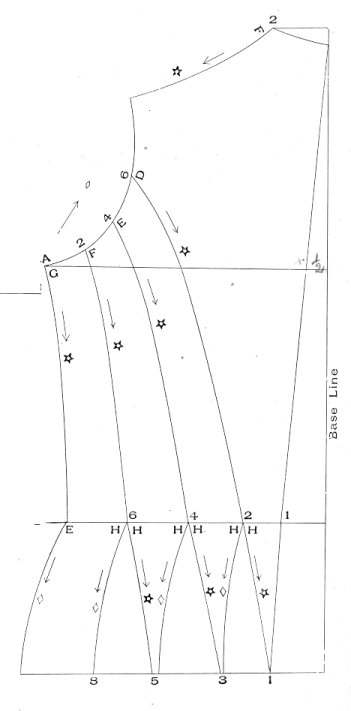
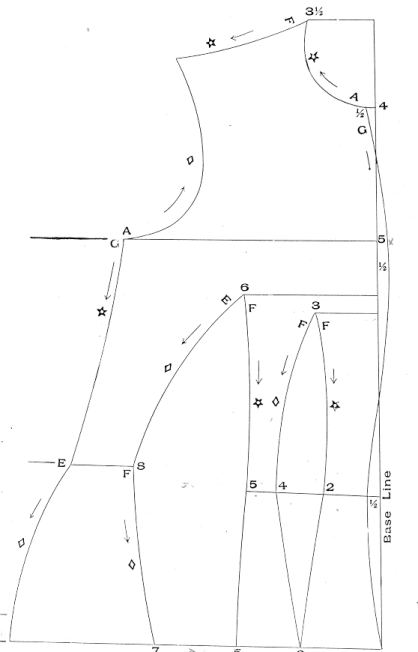
This is an optional body style form suggested by several tailor's guides for stout figures
(bust measure over 40-43")
This particular one is from a pattern drafting system called the Standard Square Inch Tailor System.
The main differences found in this and the "normal" bodice patterns are this one has a larger outside
dart on the front body. (We will learn how to adjust for this when we draft the pattern)
and the fact there are TWO underarm pieces instead of one.
"...The double side form and French Bias dart add a very desirable change in the appearance of stout forms.
On account of the two side forms the whole Basque displays a very slender appearance, and in connection with the
bias dart, the garment, while it adds ease and comfort to the wearer, also adds grace and elegance to the whole
form."
(I have also seen the double side form used in very early German dressmaker's systems- see Norah Waugh's- The Cut
of Women's Clothing.)
This particular bodice cut can be very effective in a striped fabric, but it is not for the flat of chest.
Some great books for this are:
Patterns of Fashion - by Janet Arnold
The Cut of Women's Clothing by Norah Waugh
Cutting a Fashionable Fit by Claudia Kidwell
More Patterns to Browse
Patterns as Printed in Harper's Bazar from Costumer's Manifesto
La
Couturière Parisienne Costume and Fashion Site-1880 patterns
Lesson 1-Page 6
Lesson Index
Page 1- 2 - 3 - 4 - 5 - 6 - 7 - 8
- 9
Copyright 2001 by Marna Jean Davis. All contents of the websites
associated with the lessons of Marna Jean Davis and Shooting Star Enterprises are protected by U.S. copyright laws.
They may be printed out by registered students for their own personal use but may not be reprinted in any other
manner or reproduced in any form.
Costume Classroom is a division of The Costume Gallery, copyright 1997-2001.
Having problems with this webpage contact: questions@costumeclassroom.com